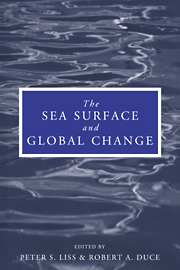Book contents
- Frontmatter
- Contents
- List of contributors
- Preface
- 1 Report Group 1 – Physical processes in the microlayer and the air–sea exchange of trace gases
- 2 Report Group 2 – Biological effects of chemical and radiative change in the sea surface
- 3 Report Group 3 – Photochemistry in the sea-surface microlayer
- 4 Transport processes in the sea-surface microlayer
- 5 The role of organic films in air–sea gas exchange
- 6 Bubbles and their role in gas exchange
- 7 The physical chemistry of air–sea gas exchange
- 8 The sea-surface microlayer and its effect on global air–sea gas transfer
- 9 Chemistry of the sea-surface microlayer
- 10 Biophysics of the surface film of aquatic ecosystems
- 11 Biological effects of chemicals in the sea-surface microlayer
- 12 Neuston of seas and oceans
- 13 Photochemistry in the sea-surface microlayer
- 14 Hydrocarbon breakdown in the sea-surface microlayer
- 15 Applications of laser technology and laser spectroscopy in studies of the ocean microlayer
- 16 Remote sensing of the sea-surface microlayer
- Index
Preface
Published online by Cambridge University Press: 24 September 2009
- Frontmatter
- Contents
- List of contributors
- Preface
- 1 Report Group 1 – Physical processes in the microlayer and the air–sea exchange of trace gases
- 2 Report Group 2 – Biological effects of chemical and radiative change in the sea surface
- 3 Report Group 3 – Photochemistry in the sea-surface microlayer
- 4 Transport processes in the sea-surface microlayer
- 5 The role of organic films in air–sea gas exchange
- 6 Bubbles and their role in gas exchange
- 7 The physical chemistry of air–sea gas exchange
- 8 The sea-surface microlayer and its effect on global air–sea gas transfer
- 9 Chemistry of the sea-surface microlayer
- 10 Biophysics of the surface film of aquatic ecosystems
- 11 Biological effects of chemicals in the sea-surface microlayer
- 12 Neuston of seas and oceans
- 13 Photochemistry in the sea-surface microlayer
- 14 Hydrocarbon breakdown in the sea-surface microlayer
- 15 Applications of laser technology and laser spectroscopy in studies of the ocean microlayer
- 16 Remote sensing of the sea-surface microlayer
- Index
Summary
The sea-surface microlayer has often been operationally defined as roughly the top 1 to 1000 micrometres of the ocean surface. There has been considerable new research in this area over the past 5–10 years. The microlayer is known to concentrate, to varying degrees, many chemical substances, particularly those that are surface active, and many organisms live and/or find food there. It is clearly the interface through which all gaseous, liquid and particulate material must pass when exchanging between the ocean and the atmosphere. It also plays a vital role in the transfer of various forms of energy (momentum, heat) between the two media.
It is now recognized that important physical, chemical, and biological processes near the air–sea interface are not restricted to what has been traditionally referred to as the ‘microlayer’, but rather occur over gradients of varying thickness. Above the interface is an atmospheric boundary layer of 50–500 μm, where atmospheric turbulence is much reduced. Below the air-water interface the aquatic surface layer contains a series of sublayers (as described by Jack Hardy in Chapter 11). In this book, we use the term ‘microlayer’ in its operational meaning to refer to roughly the uppermost millimetre of the oceans, where properties are most altered relative to deeper waters. We also utilize the following terminology: a ‘film’ refers to a surfactant-influenced surface and a ‘slick’ refers to a visibly surfactant-influenced surface.
Information
- Type
- Chapter
- Information
- The Sea Surface and Global Change , pp. xiii - xviPublisher: Cambridge University PressPrint publication year: 1997
Accessibility standard: Unknown
Why this information is here
This section outlines the accessibility features of this content - including support for screen readers, full keyboard navigation and high-contrast display options. This may not be relevant for you.Accessibility Information
- 6
- Cited by
